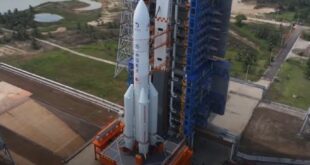
Spacecom, operator of the AMOS satellite fleet, announced today that its AMOS-17 communication satellite has successfully completed its Critical Design Review (CDR) and entered full production. Specifically designed for the African continent and scheduled for launch in early 2019, AMOS-17 will operate from 17°E to expand and strengthen Spacecom’s coverage in Africa, the Middle East, and Europe. It will offer extensive Ka-band, Ku-band and C-Band High-Throughput Satellite (HTS) services, combining broad regional beams and high throughput spot beams to maximize throughput and spectral efficiency. The satellite’s in-orbit life is expected to be 19 years.
Boeing Satellite Systems International is building the satellite and SpaceX will send it into orbit on a Falcon-9 launch vehicle.
David Pollack, President and CEO of Spacecom said, “AMOS-17, equipped with latest generation digital payload, represents the most advanced satellite over Africa and further delivers on our long-term commitment to the African market. This satellite will bring multi-band high-throughput technologies to deliver unique service capabilities not possible on traditional satellites. We are introducing cutting edge satellite technology to Africa, that combined with our customer-centric approach, makes Spacecom the ideal choice for service providers. AMOS-17 will advance our support in creating a digital Sub-Sahara Africa society.“
Original published at: https://spacewatch.global/2017/11/israels-spacecom-announces-amos-17-successfully-passes-critical-design-review/
 SpaceWatch.Global An independent perspective on space
SpaceWatch.Global An independent perspective on space

